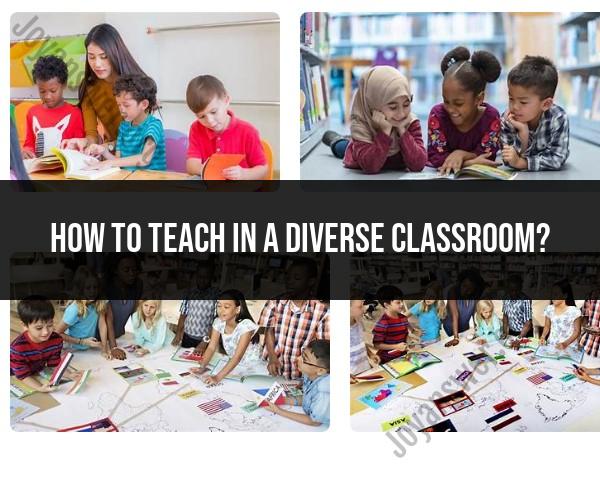How to teach in a diverse classroom?
Teaching in a diverse classroom requires thoughtful planning, sensitivity, and inclusive strategies to meet the needs of students from various backgrounds, cultures, and abilities. Here are some strategies and approaches to create an inclusive and supportive learning environment in a diverse classroom:
Cultural Competence:
- Educate yourself about the cultural backgrounds and experiences of your students. Understanding cultural differences can help you connect with students and create a more inclusive atmosphere.
Build Positive Relationships:
- Establish positive relationships with your students. Get to know them individually, learn about their interests, and show genuine care and respect for each student.
Inclusive Curriculum:
- Ensure that your curriculum reflects diversity and includes materials from various cultures, perspectives, and voices. This helps students see themselves represented and fosters a sense of belonging.
Differentiated Instruction:
- Recognize and accommodate different learning styles and abilities. Differentiate your instruction to meet the diverse needs of your students, providing multiple ways for them to engage with the content.
Varied Teaching Methods:
- Use a variety of teaching methods to cater to different learning preferences. Incorporate visual aids, group activities, hands-on experiences, and technology to engage students with diverse learning styles.
Create Inclusive Classroom Norms:
- Establish classroom norms that promote inclusivity, respect, and open communication. Encourage students to share their perspectives and experiences, fostering a sense of community.
Address Bias and Stereotypes:
- Be aware of and challenge your own biases. Address stereotypes and biases that may arise in the classroom, promoting a culture of inclusivity and fairness.
Flexible Grouping:
- Implement flexible grouping strategies that allow students to work with peers from different backgrounds. This promotes collaboration and helps break down social barriers.
Provide Multilingual Support:
- If your classroom includes students with diverse language backgrounds, provide support for multilingual learners. Use visuals, gestures, and other tools to aid comprehension, and consider offering additional language support resources.
Culturally Responsive Teaching:
- Adopt culturally responsive teaching practices that acknowledge and incorporate students' cultural backgrounds into the learning process. This can enhance engagement and make learning more relevant.
Regular Reflection:
- Reflect on your teaching practices regularly. Consider how your instructional methods and interactions impact students, and be open to adjusting your approach based on feedback.
Professional Development:
- Participate in professional development opportunities focused on diversity, equity, and inclusion. Continuous learning will help you refine your teaching strategies and stay informed about best practices.
Celebrate Diversity:
- Celebrate cultural and individual differences within the classroom. Acknowledge and appreciate diverse holidays, traditions, and achievements to create an inclusive and welcoming environment.
Collaborate with Families:
- Establish communication with students' families to better understand their cultural backgrounds and involve them in their child's education. Create opportunities for family engagement.
Remember that creating an inclusive classroom is an ongoing process, and it requires a commitment to understanding, respect, and continuous improvement. By implementing these strategies, you can create a learning environment where all students feel valued and supported.
Cultivating Inclusivity: A Toolbox for Teaching in Diverse Classrooms
Embracing diversity in the classroom can be both enriching and challenging. But fear not, educators! Here are strategies and tips to build inclusive learning environments where all students thrive:
1. Strategies for Fostering Inclusivity:
Diversity Awareness:
- Reflect on your own biases: Recognizing unconscious biases allows you to mitigate their impact on interactions and curriculum choices.
- Explore diverse perspectives: Actively seek out and incorporate knowledge, literature, and examples from various cultural backgrounds and viewpoints.
Building Community:
- Get to know your students: Encourage self-introductions, sharing of diverse experiences, and respectful dialogue.
- Celebrate differences: Organize cultural and heritage celebrations, invite guest speakers, and promote intercultural understanding.
Inclusive Pedagogy:
- Differentiate instruction: Use varied teaching methods, learning materials, and assessment strategies to cater to different learning styles and abilities.
- Promote collaboration: Encourage group work and peer learning, fostering positive interactions and appreciating diverse perspectives.
Creating a Safe Space:
- Establish clear expectations for respectful communication and behavior.
- Address discrimination and bias promptly and decisively.
- Provide support systems for students facing challenges.
2. Tips for Creating an Inclusive Educational Environment:
- Use inclusive language: Avoid gendered pronouns, stereotypes, and assumptions about cultures and identities.
- Culturally relevant curriculum: Incorporate diverse perspectives and voices into the curriculum, representing different backgrounds and experiences.
- Accessibility considerations: Ensure teaching materials and learning platforms are accessible to students with disabilities.
- Celebrate students' strengths and achievements: Recognize and value individual talents and contributions, regardless of background or learning style.
3. Navigating Challenges and Embracing Opportunities:
- Challenge stereotypes and assumptions: Encourage critical thinking and open discussions about diversity and social justice issues.
- Embrace discomfort: Difficult conversations or disagreements can be learning opportunities for promoting understanding and empathy.
- Seek support and resources: Connect with colleagues, school counselors, and diversity experts for guidance and collaboration.
- Continuously learn and grow: Reflect on your teaching practices, seek feedback from students, and actively engage in professional development opportunities.
Remember: A truly inclusive classroom is a constant work in progress. By incorporating these strategies, being open to learning, and embracing the challenges and opportunities that come with a diverse student body, you can create a classroom where all students feel valued, respected, and empowered to reach their full potential.












